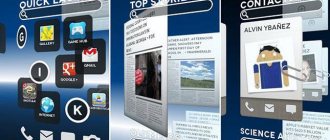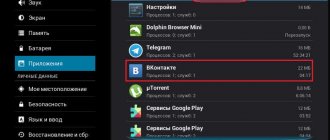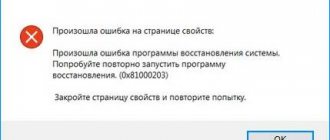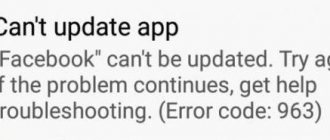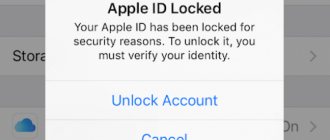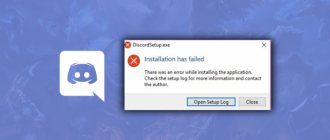PREPARATORY STEPS
To perform many of the tricks described in the article, you need root and a root that depends on it. In the standard version, it will work 100% correctly only in AOSP firmware, but even in them there may be glitches. Problems with Xposed modules can often arise in stock firmware with modifications from the manufacturer, but there is a special version of Xposed for them: for TouchWiz, for MIUI, for firmware based on Android 5.0+. HTC owners can install the official build, but S-OFF is almost always required.
Got root, installed Xposed? Then let's go.
What is this error?
The system graphical interface is a set of system options and applications responsible for graphically displaying user actions on the screen (menus, icons, buttons, various lists). GIS is connected to almost the entire Android OS shell, so localizing problems that occur with it can be very difficult. Basically, the error occurs due to:
- broken firmware, even official updates from manufacturers fail;
- problems with a specific application, when launched, a bug appears.
After the error window pops up, the phone starts to slow down terribly and may freeze on a black screen. Moreover, the failure does not depend on the device model (Huawei, LG, Lenovo, Asus, Fly, HTC).
When this error appears, the phone often hangs on a black screen.
CHANGING THE LOADING ANIMATION
The boot animation is stored in the /system/media/bootanimation.zip file. Inside there is a text document desc.txt, it indicates the frame rate, horizontal and vertical resolution, etc. There are also the images themselves (frames), which change with the frequency specified in desc.txt. The order and rules for playing animation from folders are also written in this file.
All you need to do is get the archive from the device using a file manager with root support, unpack and replace the images, remembering to first compress them to the desired resolution. Next, just pack the archive without compression and return it to its place. But, of course, it’s easier to take a ready-made archive. From hboot.co.uk
there are plenty of them.
On the other hand, although the animation is interesting to look at, it makes no sense. But it can be useful to see which services are running. The easiest option is to install LiveBoot, which outputs logcat and dmesg, i.e. Android and Linux kernel messages.
ADDING YOUR SOUNDS TO THE STANDARD SET
Sounds can be dropped into one of the folders in /system/media/audio. alarms — melodies for alarm clock; notifications - sounds for notifications; ringtones - ringtones; ui - system sounds, for example, low battery, camera focusing, selection of interface elements. Some applications may access them by default, so you can replace them with your own.
Why put ringtones in the system partition? Firstly, the files there are able to withstand a general reset to factory settings; secondly, sounds from special folders can be set to a signal (alarm sound, call, SMS receipt) in almost any application.
CHANGING FONTS
I very, very doubt the usefulness of these actions, because the standard Android font is almost perfect. But the taste and color...
You can use a special application to install fonts. For example, HiFont allows you to change fonts in the firmware of Samsung, HTC, Motorola, Lenovo, Huawei, Nokia X without root. And if you have root, then in all other devices. You can either use fonts already available in the application catalog or add your own.
But where to get them? There are three options:
- fonts taken from different firmware of Android devices can be found in the post on w3bsit3-dns.com;
- on w3bsit3-dns.com there is a good collection of user-created fonts in the next post;
- collection on XDA.
You can install fonts without using a special application. We take the .ttf files from the archive, replace them with them in /system/fonts/ (root is needed) and reboot the device.
ADDING SUPPORT FOR THEMES
Before installing the theme, HKThemeManager will show the entire list of applications to which the theme will be applied. Uncheck those that are not needed, click on “Apply theme” and reboot the device.
There is also an alternative option for installing themes - the Layers Manager application. It works in any firmware on Android 5.0+ thanks to the introduction of the RRO resource reassignment mechanism. The application's database of themes is huge and is located on the Play Market. To see it, just type Layers Theme in the search.
Keep in mind that the application does not work on firmware based on CyanogenMod: the local engine and RRO conflict.
Solution one
We figured out that this is the Android system UI. Now let's see how to restore the service to work properly:
- Go to the Play Store application. Type Google in the search bar.
- The application of the same name will appear first in the list. Remove it.
- Next you will see a similar window: “Do you want to remove all updates for this program?” Confirm this action.
- Press the “Home” key again, turn on the camera, go to the application that caused the error to appear when you entered it. If now the annoying window does not appear, then the problem is solved.
When these actions do not lead to anything, you should deactivate auto-update in the settings. This action will help avoid the bug from appearing before the new update for the Android OS.
TURNING ANDROID 5.X+ INTO ANDROID N
The Android N-ify module will help us with this. After installation, the following features from Android N will appear:
- The design of the notification panel will noticeably change. The quick settings panel will appear;
- Interesting inscriptions will appear in the settings under some items.
- For example, under Wi-Fi the name of the current access point will be written, under the “Battery” item - the remaining operating time and battery charge in percentage;
- the Easter egg will change in the “About phone” menu;
- You will quickly switch between the two most recently launched applications by double-clicking the “Recent” button.
Android N-ify also has useful settings, through which you can not only disable it, but also configure individual changes made.
Solution three
If, when figuring out that this is “Android system UI has stopped,” you remember that such an inscription appeared on the smartphone screen earlier, long before the release of the ill-fated update, then you need to go a different way:
- Go to the “Settings” menu, scroll to “Application Manager”. We will need the “Everything” tab.
- In the specified section, find “System UI”.
- First of all, click on the “Clear cache” button.
- After this action, tap on “Stop”.
- Now restart your smartphone.
- Then you will need to log into your Google account that is associated with this device and restart it. This is done simply: turn it off and synchronize it with your phone again.
- Next, you should receive a message informing you that new updates are available for your gadget. Try to apply them as soon as possible.
That's it, the problem is solved once and, hopefully, forever!
A bug related to the Android system UI may have several reasons. If this happened after a recent update of the device, then the solution occurs according to the first two presented schemes. If the reason is not obvious, then it is better to deal with the bug according to the latest instructions indicated in this material.
Owners of gadgets, both old and new generation Android operating systems, are faced with errors like: “the application has stopped.” In the English version it sounds: “Unfortunately, the process has stopped.” The malfunction affects many gadgets from well-known manufacturers: Samsung, Huawei, Lenovo, Sony Xperia, LG, Xiaomi and others.
We display the real signal level
Sometimes you need to know how well the Internet is received in different parts of the room, how the position of the smartphone affects the signal reception level, or you simply need to compare the signal reception level of your smartphone and other models. NetStrength will help with this. The module can display the cellular network signal level in decibels per milliwatt (dBm or dBm). This unit of measurement has a negative value, and the closer it is to zero, the better the reception. You can also enable the display of ASU (Arbitrary Strength Unit - signal-to-noise ratio in the pilot channel). Calculated using the formula ASU = (dBm + 113)/2.
By the way, the module can show the Wi-Fi reception level in dBm, Mbps (Mbit/s - megabits per second) and percentage.
Monitoring the loading process
Statusbar Download Progress is one of the most useful Xposed modules. It displays the download process from the Play Market or a file from the Internet in the form of a thin white bar above the status bar. I immediately recommend activating “God Mode”, thanks to which progress will be displayed for any applications that have a progress bar. In the settings you can set the display above the status bar or below the line.
Every time we hear about a smartphone, we also hear mention of its user interface. Many devices run Android, but what do users mean when they say the HTC 10 has Sense and the Galaxy Note 5 has TouchWiz? Below, in our short comparative review, we will tell and show you how a number of common user interfaces differ from each other.
Firstly, what do we mean by user interface? Despite the fact that all the devices that will be identified a little later have Android, this OS is characterized by different guises. The Nexus 5X, like other Nexus devices, includes a stock version of Android, while other smartphone makers use it to create their own versions. These branded interpretations of Android are sometimes called “forked” versions.
Why not use a common interface across all mobile devices?
Device manufacturers use their own kinds of interfaces for many reasons, although the main reason is the word “branding.” Android's ability to customize means that proprietary hardware manufacturers (also known as OEMs) have the ability to make their own tweaks to the software, particularly in the areas of design and functionality.
In reality, all these different user interfaces don't have much impact on your user experience, since they are all designed to perform universal tasks. The only difference is in the set of applications that come with these interfaces.
It's important to understand that third-party user interfaces often differ between devices from the same manufacturer. For example, TouchWiz on the Samsung Galaxy S5 looks a little different than on the Galaxy S7, even if both are paired with the latest version of Android.
Likewise (while it may seem obvious), different versions of stock Android's interface may look different. For example, Android Lollipop is not exactly identical to Android Marshmallow.
Basic user interfaces for Android
Below we provide a list of some of the main user interfaces for Android, and also look at their appearance and functionality.
TouchWiz
TouchWiz is a custom shell for Android from Samsung. Loved by some, hated by others, this interface is so ubiquitous that it is the first thing that comes to mind for many people when they think of Android, despite the fact that it is very different from the standard version.
The current version of TouchWiz is based on an azure blue palette, with shades of white and gray. Whether you like it or not, this interface can be seen today in all devices from Samsung - be it tablets or smartphones of various price categories.
When you put your device on charge, the lock screen displays the clock, date, and charge level as a percentage. The home screen icons and keys have a typical Samsung look, with the familiar flower image on the Gallery app icon and a simple yellow Messages app icon. Note that the Applications icon is located at the bottom right of the screen, rather than in the more usual bottom-center location. Plus, the Google search bar is in the middle of the display, not at the top.
The symbols found on home screens these days are also Samsung's own: the main home screen, or home screen (the one with the weather or clock widget by default) is represented by a house icon. The news menu, presented by Flipboard on the leftmost screen, is depicted as two side bars, while the other home screens appear as small dots. Plus, the app drawer has a transparent background, unlike many other interfaces, and it can be scrolled horizontally.
The notification panel has a design that can be called the biggest visual difference when comparing the interface in question with others. Time and date icons appear in the upper left corner of the screen, and option icons are located lower throughout the display. Also in the notification panel there is a display brightness adjustment slider, which is present at the bottom of the screen.
TouchWiz is generally characterized by its grey, white and blue color tones, all of which are very noticeable in the Quick Settings menu, which includes various round icons.
Xperia UI
Xperia UI is a user interface from Sony. Similar to TouchWiz, it occupies a different aesthetic niche compared to stock Android, and has certain differences from them.
Since Sony smartphones got rid of the physical Home key, the Back, Home and Recents keys have become part of the software interface. Externally they are presented in the form of a triangle, pentagon and square.
Like most manufacturers, Sony uses its own custom icons for calls, messages and contacts. The application menu is located at the bottom center of the screen, with the various home screens depicted as dots above it. Unlike Samsung, HTC and LG, Sony's user interface does not have a news feed on the left side of the display.
The interface's wallpaper consists of bright colors, although its menu is presented in gray and black, and the application launcher has a transparent background (same as TouchWiz).
Xperia UI also includes some of Sony's own apps, such as Music, Album, Video, or .
The Xperia UI's notification panel and quick settings menu are essentially the same as stock Android, but the settings menu is noticeably different. In this interface you'll find the company's theme store, some advanced audio options (including an equalizer), and various power-saving modes.
And finally, let’s say that Sony paid quite a lot of attention to the camera software, which includes manual and automatic modes, coupled with many special settings and plug-ins.
Sense
Sense is a user interface from Taiwanese manufacturer HTC. The latest version of this interface consists of a set of icons and widgets, flavored with a Material Design aesthetic, and at the moment it is largely similar to the stock version of Android. The recent applications menu, notification panel and quick settings menu are almost the same in appearance as stock Android, although the home screens and application launcher have certain differences.
HTC has a dedicated news feed on the far left screen, known as Blinkfeed, which can be customized to suit your personal preferences. Sense also features a vertically scrolling app launcher with a gray background that gives it a business-like appearance.
Similar to TouchWiz and Xperia UI, Sense has a theme store so you can customize your smartphone the way you want. This interface's settings menu is largely similar to stock Android, with the exception of some special additions, such as the BoomSound menu for customizing sound profiles.
Also note that Sense has its own power saving modes, swipe gestures and transfer options for receiving content from another device (for example, when updating). Such customizations include a number of additional features to the standard Android package.
LG UX
LG UX is a proprietary user interface created by LG, which is one of the first things that comes to mind when using an LG smartphone with a strange combination of default wallpapers. Things have improved a bit with the LG G5, but we still don't really like the green-purple color of the home screen.
The flagship LG G5 device has flat, square-shaped icons, and like the Emotion UI below, it lacks an app drawer. This means that all apps are placed on your home screens.
The notification panel is slightly different from stock Android. At the top left you can see time and date icons, as well as quick access to settings, accompanied by shortcut buttons on the slide panel. The display brightness level control is also located here.
We would also like to note the fact that in the interface in question, users do not have the ability to enable or disable mobile data transfer directly from the default quick access panel. However, such a function can be dragged into this panel if you wish.
Among other things, LG UX has a feed called Smart Bulletin, which by default includes updates for applications such as Calendar, Music, Evernote and LG Health.
Emotion UI
Huawei's proprietary user interface is called Emotion UI, which is also known as EMUI. Similar to LG's UX, EMUI lacks an app launcher, which is one of the reasons why it's often compared to iOS.
By the way, the similarity with iOS, periodic performance problems and the somewhat illogical menu of this interface are very often criticized. However, there are a number of features in EMUI that can be considered worthy improvements over the stock Android system.
Note that the shape and color of Huawei’s interface icons varies depending on the specific device model, but the above-mentioned manufacturer, as a rule, uses a square shape (with rounded corners), as well as white or beige colors. In our opinion, the lock screen in EMUI is one of the most unique among many mobile devices, and it can be used to access additional functions, such as a flashlight or voice recorder.
As they say, there is no smoke without fire, and in some cases EMUI still lags behind its Android competitors. However, Huawei has made significant strides in recent years, and given the manufacturer's growing popularity, there is no doubt that it will continue these challenges in the future.
Stock Android
The stock version of Android is also the interface found in Google devices. For some people, this is the gold standard for Android - real Android, without any third-party modifications. Overall, the main advantage of Stock Android compared to other user interfaces is the speed with which devices with such an interface work and receive updates. We are not at all surprised by this - Google creates software that its mobile devices receive first.
Another key aspect of the attractiveness of the interface in question is that it has been optimized for the internal components of the device. Google (in partnership with another OEM) releases only a few models a year specifically designed for the new version of Android. Other companies are releasing a variety of models designed to update their own user interfaces for the current generation of hardware.
Let's also say that the stock Android interface uses flat, colorful icons, a vertically scrolling app launcher, and beautiful animations.
Fixing the error: com.android.systemui has stopped
Have you encountered a notification on your tablet or smartphone: “ An error has occurred in the com.android.systemui application ”? Or are you looking for information about similar errors? In any case, in this article you will learn:
- detailed information about the reasons for the application error;
- troubleshooting instructions.
So, the com.android.systemui process has stopped, what should I do in this case?
What is this application?
com.android.systemui is a system application that is responsible for properly configuring the graphical user interface in the Android shell. The service is essential, so disabling it may have undesirable consequences. Basically, this kind of error can appear due to:
- conflict with applications installed on the smartphone;
- software failure;
- presence of a virus in the Android device system.
Important! Owners of Samsung smartphones , after a recent update, encountered this error en masse. It appears after pressing the Home button. This is all due to crooked system updates of some Google services. If you have not flashed (rooted) your gadget, go straight to the “Uninstall Google updates” item.
How to determine whether it is a virus or not?
How does the virus manifest itself? It disguises itself as a system file and starts downloading unknown third-party applications, which in turn display advertisements on the smartphone itself. Often this is intrusive advertising, and sometimes of an obscene nature. A Trojan may appear in the system when:
- custom Android firmware;
- downloading applications from unknown sources;
- downloading “one-day” applications from the Play Market, etc.;
- downloading and subsequent launching of malicious files from the Internet, email, instant messengers, etc.
Remember if anything similar happened to your device before the error appeared. Also check the creation date of the com.android.systemui file itself (via the standard application manager, in properties). If the date coincides with other system files, then most likely there was an error in the operation of the system file. If the file appeared recently, it is probably a virus.
Advice! On Android devices, the error code carries certain information. For example, com.android.phone means that: com is an error in the system application, phone is a malfunction in the standard “Phone” program.
Troubleshooting a system error
If, during the data analysis process, nothing indicated a virus, there was probably a simple error in the system file. The error may not appear again after rebooting the system, so reboot Android first. If this doesn't help, try the following steps in order.
Uninstalling Google updates
Follow these steps:
- Open Play Market and enter the word “Google” in the search bar.
- Select Google and click Remove.
- When the “Uninstall all updates to this Android system app” notification appears, click OK.
- After deleting, close the Play Market and check, the error should go away.
- If this does not happen, go to the next step to disable auto-detection of Date and Time.
date and time
Almost any error in devices running Android can occur due to a failure to automatically detect the time zone or time. You can read more about this in the article “Setting the date and time on Android.”
To configure the date and time manually:
- Select Settings - Date and Time.
- Uncheck "Auto detect time zone".
- Reboot your device and check Android for this error. If necessary, set the date, time and time zone manually.
Data cleaning
Advice! If you want to know in detail what a cache is, why it is needed and why it is cleared, read the detailed information.
To clear application data:
- Go to Settings and select Application Manager.
- Open com.android.systemui and click “Clear Data” (if active, “Clear Cache”).
- Restart your smartphone and check for the error.
Factory reset
If the previous methods did not bring results, reset the system to its factory state. Such a reset deletes all personal data and returns the tablet, smartphone or other Android device to its original state.
To save data, make a system backup (saving all personal data). The built-in functions of the operating system or special applications, such as Titanium Backup, can help create a backup.
In order for the program to make a backup, it needs to be granted root rights (administrator or superuser rights).
The reset can be done in two ways:
Virus removal
Having determined that there is a Trojan in the Android OS, you need to remove it. It is likely that a malicious application was loaded on the system before the error appeared. You need to get rid of it first. Find out what the program is by searching for it by installation date. For this:
- Go to Explorer (ES Explorer is best).
- Open the Tools tab - Task Manager (install the module if necessary).
- Go to the menu and select Applications.
- Click on the three vertical dots on the right and select View.
- Set the view to “Average detail” and the sorting to “Changed”.
- Look for the desired program among the installed ones. A viral application may be called Sustem UI or hidden under another name.
- Go to application properties. Click: “Clear data”, “Clear cache”, “Stop”, “Delete application”.
- Go to the system file com.android.systemui. Until you get root rights, you will not be able to change/delete system files.
- To obtain root rights, use the special programs indicated in the link.
- Go to the file manager (ES Explorer, Root Uninstaller or any other application from the Play Market), which allows you to work with root rights. Go to the Root/System/App .
- Find the com.android.systemui application and remove it. It may be called differently, so remember when the Trojan appeared on the Android device and calculate it based on the date of creation.
- If ES Explorer cannot remove this file, use another application (“Root Uninstaller”, “application manager (ROOT)”).
- Reboot your device and check operation.
Source: https://vr4you.net/35-unfortunately-the-process-com-android-systemui-has-stopped.html
Which interface is the best?
This question is too subjective for a precise answer: each user has his own tastes and preferences. It may sound like a cop-out, but one of Android's greatest strengths is that it offers so many interfaces to choose from. We're sure most people prefer the stock Android experience, although we always like to see the little changes OEMs include in their software.
Which Android interface do you think is the best? Tell us about it in the comments.
Software errors in the Android operating system occur quite often; most users find unpleasant moments in use. Today’s article is devoted to the problem of the operating system in which the message “ system graphical interface error”
". Over the course of the article, we will look at possible problems, and then we will give advice on how to eliminate this problem.
After collecting information from various Internet resources, we identified common causes of the error.
- There is a conflict between the system and any of the installed applications, games and other software; what to do in this case, read in the paragraph below;
- The problem appeared after the virus, and the files necessary for the full functioning of the system were damaged or deleted. The virus can “eat” such files. For what? Either they interfere with it, threaten its detection, and then they need to be overwritten, deleted, or simply to harm users;
- The system's graphical interface cache is clogged. It's rare, but it does happen;
- If you have “Launcher” installed (the launcher is a system shell. Everything you see on the screen when using your smartphone is displayed by the launcher). It may be damaged or also damaged by a virus;
What is the reason?
GUI Error
, often caused by a software glitch. For example, you installed some application that interferes with the operation of the standard launcher or shell in general. It may also be that after flashing such a problem appears due to the fact that you did not do all the wipes (full cleaning) and there are tails left from the previous ROM. As a result, we have the following situations:
How to fix GUI errors
Now that we’ve sorted out the reasons, let’s talk about ways to resolve the conflict. Try to remember whether the error appeared after installing an application or whether it popped up “suddenly”. If the message appears after installing the software, we recommend the following operations:
When the GUI crash is caused by a virus, the situation becomes more complicated; everywhere they immediately advise doing a general reset
to factory settings - this helped few people and here's why.
Master reset when solving problem
Master reset - will return the smartphone configuration to factory settings. In other words, all third-party programs and information will be deleted. The theme, language and account settings will be reset. When malware penetrates the device, it deletes some files embedded in the system, system files. By performing a master reset, you will roll back the settings, but the deleted files will not be restored.
Flashing a smartphone
Reflashing is a 100% proven way to combat this problem. Mentally come to terms with the fact that you will have to delete all your data; first save your contacts, photos, and music.
Do not “backup applications”, the virus will remain in the infected files.
Applications and games can be easily downloaded in a couple of hours from the Play Market. If you have recovery installed on your phone, flash it from there. To get into recovery with the phone turned off, you need to hold down the “volume +” and power button. When the menu opens, use the volume keys to select and activate the “ Wipe data/Factory Setting
". If the words recovery and firmware are not familiar to you, there is a lot of information on the Internet for any phone; flashing should be done with caution so as not to turn the phone into a brick. If you don’t have the time or knowledge to dig, entrust this matter to professionals or a service center. I hope you have figured out the reasons why the system’s graphical interface application crashes and know how to fix the situation. If you know proven ways to resolve this conflict, write in the comments, we will definitely add them to our article, ask questions. A short video on troubleshooting for 5 versions of Android firmware, test for your system:
What is this error?
The system graphical interface is a set of system options and applications responsible for graphically displaying user actions on the screen (menus, icons, buttons, various lists). GIS is connected to almost the entire Android OS shell, so localizing problems that occur with it can be very difficult. Basically, the error occurs due to:
- broken firmware, even official updates from manufacturers fail;
- problems with a specific application, when launched, a bug appears.
After the error window pops up, the phone starts to slow down terribly and may freeze on a black screen. Moreover, the failure does not depend on the device model (Huawei, LG, Lenovo, Asus, Fly, HTC).

